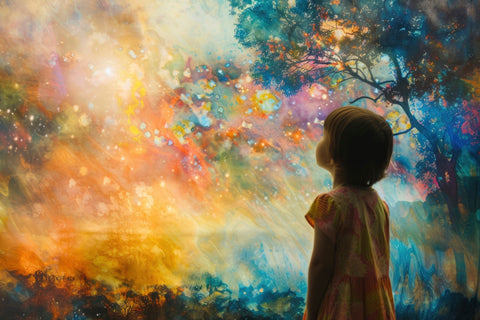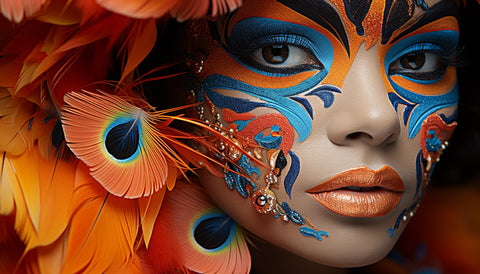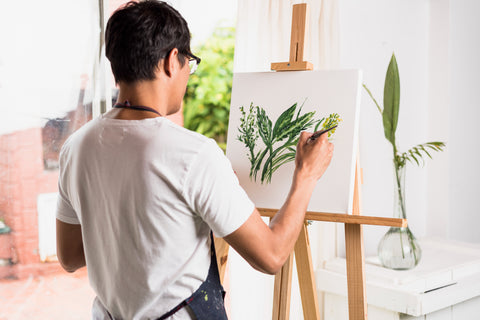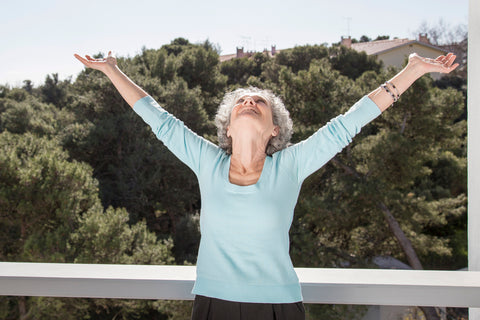
How Art Can Heal Your Inner Soul
Share
Art has always held a special place in the human experience. Whether it be through painting, music, writing, or dance, art has the power to evoke emotions, spark creativity, and transport us to another world. Beyond its aesthetic appeal, art has the ability to heal and nourish our inner souls. In this blog post, we will explore the profound connection between art and healing, and how incorporating art into our lives can bring about a transformative and cathartic experience.
Understanding Art and Its Connection to the Soul
Art is not just a mere collection of colors, sounds, or words; it is a medium through which we can express our deepest thoughts and emotions. From ancient cave paintings to modern abstract masterpieces, art has served as a means of communication, self-expression, and reflection. It allows us to delve into the depths of our inner selves, making sense of our experiences, and finding solace in the beauty and complexity of the world around us.

Art as a Form of Self-Expression and Healing
One of the most powerful aspects of art is its ability to serve as a form of self-expression. When words fail to convey our innermost feelings, art steps in to bridge the gap. Through art, we can communicate our joys, sorrows, hopes, and fears in a way that transcends language. This act of self-expression can be incredibly therapeutic, providing a release for pent-up emotions and a pathway to healing.
The Therapeutic Power of Creativity
Engaging in artistic activities stimulates our creativity and imagination, allowing us to tap into a deeper part of ourselves. This creative process can be incredibly healing, as it encourages us to explore our inner worlds, confront our fears, and discover new perspectives. Whether it be painting, sculpting, writing, or dancing, the act of creating art can bring a sense of fulfillment, joy, and a renewed sense of purpose.
Art as a Reflection of Inner Emotions
Art has a unique ability to reflect our inner emotions and experiences. When we engage with art, we often find that it resonates with our own feelings and experiences on a profound level. This reflection can provide us with a sense of validation and understanding, as we realize that we are not alone in our struggles or triumphs. It can also serve as a mirror, allowing us to gain insight into our own thoughts and emotions, leading to personal growth and healing.
Healing Through the Creation Process
The act of creating art itself can be a healing process. As we immerse ourselves in the creative process, we enter a state of flow, where time seems to stand still and our worries fade away. This state of flow is often described as a meditative experience, where we are fully present and connected to the present moment. This deep focus and concentration can provide a respite from the stresses of daily life, allowing us to find inner peace and healing.
In the upcoming sections of this blog post, we will explore the different art forms and their impact on healing, how to incorporate art into your healing process, and the role of art therapy and professional help. By embracing art as a tool for healing, you can embark on a transformative journey of self-discovery and personal growth. So, let's dive in and discover how art can heal your inner soul.

Understanding Art and Its Connection to the Soul
Art has always been deeply intertwined with the human soul. It has the power to touch us on a profound level, evoking emotions, stirring our imagination, and connecting us to something greater than ourselves. But what is it about art that makes it so intimately connected to our souls? In this section, we will delve into the essence of art and explore its profound connection to the soul.
The Universal Language of Art
Art transcends barriers of language, culture, and time. It speaks to us in a universal language that bypasses the constraints of words. Whether we are viewing a painting, listening to music, or reading a poem, art has the ability to communicate directly with our souls. It bypasses the analytical mind and taps into our deepest emotions and experiences. Art has the power to evoke joy, sadness, awe, and a myriad of other emotions, creating a profound connection between the artist and the viewer.
Art as a Mirror of the Human Experience
Art reflects the human experience in all its complexity. It captures the essence of what it means to be human – our struggles, triumphs, hopes, and dreams. When we engage with art, we often find that it resonates with our own lived experiences. We see ourselves reflected in the brushstrokes of a painting, the lyrics of a song, or the words of a poem. This reflection allows us to feel understood and validated, fostering a deep connection between the art and our souls.
Art as a Portal to the Subconscious
Art has the ability to access the depths of our subconscious minds. It can uncover buried emotions, memories, and desires that lie beneath the surface of our conscious awareness. Through art, we can tap into the hidden recesses of our souls, exploring our fears, traumas, and innermost desires. This process of self-discovery and introspection can be both cathartic and transformative, leading to healing and personal growth.
Art as a Source of Inspiration and Transcendence
Art has the power to inspire us and transport us to a realm beyond our everyday existence. It can awaken our imagination, ignite our passions, and expand our perspectives. When we engage with art, we are invited to step outside of ourselves and enter into a world of beauty, creativity, and possibility. This transcendence allows us to connect with something greater than ourselves, whether it be the divine, nature, or the collective human experience.
The Healing Power of Beauty
Beauty has long been associated with healing. When we encounter something beautiful, whether it be a breathtaking landscape, a mesmerizing piece of music, or a captivating work of art, it has the power to uplift our spirits and bring us a sense of inner peace. Beauty can serve as a balm for the soul, providing solace in times of difficulty and reminding us of the inherent goodness and wonder of the world.
In summary, art is deeply connected to the soul. It speaks a universal language, reflects the human experience, accesses our subconscious minds, inspires transcendence, and offers healing through beauty. By embracing art and exploring its profound connection to our souls, we can tap into a wellspring of creativity, self-expression, and healing. In the next sections, we will explore different art forms and their specific impact on healing.

Art as a Form of Self-Expression and Healing
Art has long been recognized as a powerful form of self-expression. It provides a platform for individuals to communicate their thoughts, emotions, and experiences in a way that goes beyond words. In this section, we will explore how art serves as a form of self-expression and how it can facilitate healing.
The Therapeutic Power of Creativity
Creativity is an inherent part of the human experience. When we engage in creative activities, such as painting, drawing, or writing, we tap into a wellspring of imagination and self-expression. This act of creation can be deeply therapeutic, allowing us to explore our inner worlds, process our emotions, and find solace in the act of bringing something into existence.
Through art, we have the freedom to express ourselves in ways that may not be possible through traditional means of communication. We can convey our deepest joys, sorrows, fears, and desires, giving voice to the complex array of emotions that reside within us. This creative process can be cathartic, providing a release for pent-up emotions and a pathway to healing.
Art as a Reflection of Inner Emotions
Art has the unique ability to reflect our inner emotions and experiences. When we engage with art, whether as creators or observers, we often find that it resonates with our own feelings and experiences on a profound level. The colors, shapes, lines, and textures in a painting can evoke a sense of joy, sadness, or tranquility. The melodies and rhythms in music can stir our emotions and transport us to different emotional landscapes.
Through art, we find a mirror that reflects our innermost thoughts, desires, and struggles. This reflection can provide us with a sense of validation and understanding, as we realize that we are not alone in our experiences. It can also serve as a catalyst for self-discovery, helping us gain insight into our own thoughts, emotions, and patterns of behavior.
Healing Through the Creation Process
Engaging in the process of creating art can be an inherently healing experience. As we immerse ourselves in the act of creation, we enter a state of flow, where time seems to stand still and our worries fade away. This state of flow is often described as a meditative experience, where we are fully present and connected to the present moment.
The act of creating art allows us to focus our attention and energy on something outside of ourselves. It provides a respite from the stresses of daily life and a means of channeling our emotions into a productive and meaningful outlet. Whether it be painting, sculpting, writing, or dancing, the act of creating art can bring a sense of fulfillment, joy, and a renewed sense of purpose.
Through the creation process, we can also gain a deeper understanding of ourselves. We may discover hidden talents, uncover new perspectives, and confront our fears and limitations. Art allows us to push boundaries, take risks, and embrace vulnerability. In doing so, we embark on a journey of self-discovery and personal growth.
In the next sections, we will explore different art forms and their specific impact on healing. By embracing art as a form of self-expression, we can tap into the transformative power of creativity and embark on a journey of healing and self-discovery.

Different Art Forms and Their Impact on Healing
Art takes on many different forms, each with its unique ability to impact our healing process. In this section, we will explore a variety of art forms and delve into their specific impact on healing.
Visual Art and Healing
Visual art encompasses a wide range of mediums, including painting, drawing, sculpture, photography, and more. Engaging with visual art can have a profound impact on our healing journey. Creating visual art allows us to express ourselves visually, using colors, shapes, lines, and textures to convey our emotions and experiences. It can serve as a therapeutic outlet for releasing pent-up emotions, processing trauma, and finding inner peace.
Moreover, engaging with visual art as an observer can also be healing. Viewing a powerful piece of artwork can evoke deep emotions, provide solace, and foster self-reflection. Whether it be visiting an art gallery, exploring street art in a vibrant city, or creating art in the comfort of our own homes, visual art offers a powerful medium for healing and self-exploration.
Music and Its Therapeutic Effects
Music has a universal language that can touch our souls and bring about profound healing. Engaging with music can evoke a wide range of emotions, from joy and excitement to sadness and nostalgia. Listening to music can provide comfort, uplift our spirits, and help us process our emotions. It has the power to transport us to different emotional landscapes, allowing us to find solace or release in the melodies, rhythms, and lyrics.
In addition to listening to music, creating music can also be a therapeutic experience. Playing an instrument, singing, or composing music allows us to express ourselves in a unique and powerful way. Music can serve as a form of self-expression, a means of connecting with others, and a source of personal growth and healing.
Writing as a Form of Catharsis
Writing has long been recognized as a cathartic and healing practice. Through writing, we can put our thoughts and emotions into words, creating a tangible record of our inner experiences. Journaling, poetry, storytelling, and other forms of writing can provide an outlet for self-expression, self-reflection, and personal growth.
Writing allows us to explore our thoughts, process our emotions, and make sense of our experiences. It can be a tool for self-discovery, as we uncover hidden insights and gain a deeper understanding of ourselves. Whether writing for ourselves or sharing our words with others, writing can be a transformative practice that aids in our healing journey.
Dance and Physical Healing
Dance is a powerful art form that combines movement, rhythm, and expression. Engaging in dance can have a profound impact on our physical and emotional well-being. Dance allows us to connect with our bodies, release tension, and express ourselves through movement. It can be a form of exercise that promotes physical health and vitality.
Moreover, dance has the ability to tap into our emotions and serve as a means of emotional expression and release. Through dance, we can channel our emotions, process trauma, and find a sense of freedom and liberation. Whether it be through structured dance classes, improvisation, or simply dancing in our own space, engaging in dance can be a transformative experience that aids in our healing journey.
In the next section, we will explore how to incorporate art into our healing process. By embracing different art forms, we can tap into their specific impact on healing and find solace, expression, and growth along the way.

How to Incorporate Art into Your Healing Process
Incorporating art into your healing process can be a powerful and transformative journey. Whether you are a beginner or an experienced artist, there are various ways to embrace art as a means of healing. In this section, we will explore practical steps and strategies to incorporate art into your healing process.
Discovering Your Preferred Art Form
The first step in incorporating art into your healing process is to discover which art form resonates with you the most. Experiment with different art forms such as painting, drawing, writing, music, dance, or any other creative medium that piques your interest. Explore various techniques, styles, and materials to find the one that allows you to express yourself authentically and comfortably.
Keep in mind that there are no right or wrong choices when it comes to art forms. The goal is to find the one that speaks to your soul and provides a sense of fulfillment and joy. Trust your instincts and follow your creative curiosity to discover the art form that resonates with you on a deep level.
Creating a Safe Space for Artistic Expression
Creating a safe and nurturing space for artistic expression is essential for your healing journey. Find a dedicated area in your home or a local studio where you can freely explore your art without distractions or judgments. Set up your art supplies, create an ambiance that inspires creativity, and make it a personal sanctuary where you feel comfortable and at ease.
It is also important to create emotional safety within yourself. Allow yourself to be vulnerable and open to the process of self-expression through art. Release self-criticism and embrace self-compassion as you embark on your healing journey through art. Remember that art is a personal expression, and there are no right or wrong outcomes. Focus on the process rather than the end result, allowing yourself to explore, experiment, and grow.
Consistent Practice and Patience
Consistency and patience are key when incorporating art into your healing process. Make art a regular part of your routine, setting aside dedicated time each day or week to engage in creative activities. Just like any skill, artistic abilities develop and flourish with consistent practice.
Be patient with yourself as you explore and grow in your artistic journey. Healing takes time, and artistic expression is a gradual process. Embrace each step of the way, celebrate your progress, and allow yourself to learn and evolve as an artist.
Sharing Your Art for Deeper Healing
Sharing your art with others can be a powerful way to deepen your healing process. It allows you to connect with like-minded individuals, receive support, and gain insights from different perspectives. Consider sharing your art with trusted friends, family members, or joining art communities and organizations where you can showcase your work and engage in meaningful discussions.
Sharing your art can also be a form of advocacy or raising awareness about important issues. It allows you to use your creative expression to make a positive impact in the world and connect with others who resonate with your message.
Incorporating art into your healing process is a personal and unique journey. By discovering your preferred art form, creating a safe space for artistic expression, practicing consistently, and sharing your art, you can tap into the transformative power of art and embark on a profound healing journey.

Art Therapy and Professional Help
While incorporating art into your healing process can be a powerful and transformative journey, there may be times when seeking professional help and guidance is beneficial. Art therapy is a specialized field that combines the healing power of art with the expertise of trained professionals. In this section, we will explore the role of art therapy and how to find qualified art therapists to support you in your healing journey.
When to Consider Art Therapy
Art therapy can be beneficial for a wide range of individuals, regardless of age or artistic skill level. It can be particularly helpful if you are struggling with emotional challenges, trauma, stress, anxiety, depression, or other mental health issues. If you find it difficult to express your emotions verbally, or if you are looking for a creative and alternative approach to therapy, art therapy may be a suitable option.
Consider art therapy if you are seeking a safe and supportive environment to explore your emotions, gain self-awareness, and develop coping strategies. Art therapists are trained to work with individuals from diverse backgrounds and tailor their approach to meet your specific needs.
How Art Therapists Can Assist
Art therapists are trained professionals who combine their knowledge of psychology, art, and therapeutic techniques to support individuals in their healing process. They provide a non-judgmental and supportive space for you to express yourself through art and explore the underlying emotions and meanings behind your creations.
Art therapists can help you navigate through your artistic journey, offering guidance, interpretation, and insights into your artwork. They are skilled in facilitating self-reflection, promoting self-discovery, and providing tools and techniques to enhance your healing process. Through various art-based interventions, they can help you process emotions, develop coping skills, improve self-esteem, and promote personal growth.
Finding a Qualified Art Therapist
When seeking art therapy, it is important to find a qualified and licensed art therapist who aligns with your specific needs and goals. Consider the following steps to find a suitable art therapist:
-
Research: Look for art therapy organizations, associations, or directories that provide a list of registered art therapists in your area. These resources often include information about their expertise, qualifications, and contact details.
-
Consultation: Reach out to potential art therapists and schedule an initial consultation. Use this opportunity to discuss your needs, ask questions about their approach, and determine if there is a good fit between you and the therapist.
-
Experience and Credentials: Inquire about the art therapist's credentials, education, and experience. Ensure that they have the necessary qualifications and certifications to practice art therapy.
-
Compatibility: It is essential to feel comfortable and safe with your art therapist. Consider their personality, communication style, and approach to therapy to ensure a positive therapeutic relationship.
-
Referrals and Recommendations: Seek referrals from trusted sources such as healthcare professionals, friends, or family members who have had positive experiences with art therapy. Their recommendations can provide valuable insights and help you make an informed decision.
Remember that finding the right art therapist may take time, and it is essential to trust your instincts and choose someone with whom you feel a sense of trust, rapport, and connection.
Incorporating art therapy into your healing process can provide a supportive and transformative experience. By working with a qualified art therapist, you can harness the therapeutic power of art and receive professional guidance to aid in your healing journey.
